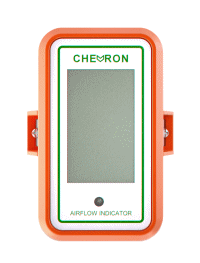Contact Monitair at sales@monitair.co.uk
How to take the hassle out of fitting LEV airflow indicators
The HSE recommends that airflow indicators should be fitted to all Industrial Ventilation, or Local Exhaust Ventilation (LEV) systems.*
- Inspection companies check that airflow indicators (or LEV Monitors) are fitted to all LEV extraction points as part of the compulsory Thorough Examination and Test (TExT).
- Fitting airflow indicators greatly improves the safety of personnel using an LEV or Industrial Ventilation system.
… but fitting them can be a real hassle.
Unfortunately most airflow indicators are generic mechanical pressure gauges, and are supplied with a preset measurement range. They often have fixed green and red regions, but the significance of the region boundaries is not always clear.
 Using these time-proven devices is better than not fitting airflow indicators at all, but a successful installation requires you to
Using these time-proven devices is better than not fitting airflow indicators at all, but a successful installation requires you to
- set up and balance the LEV system, then
- measure the static pressure at each exhaust point, then
- order the correct gauge for each point, then
- wait for the gauges to arrive, then
- fit the correct gauge to the correct point.
… which is complex, repetitive, time-consuming and TEDIOUS.
Is there another way?

At Monitair, we believe that the best way to show LEV users that their environment is safe to work in, is to use an airflow indicator, or LEV monitor, which has been specifically designed and manufactured for LEV systems. It should be quick and easy to set up as the LEV is being installed and commissioned, or just as easily retro-fitted to existing installations.
The result is the Chevron, a user-friendly, highly visible, microprocessor-controlled electronic airflow indicator, which instantly shows if the industrial ventilation is working as it should.
… making the invisible VISIBLE.


Our aim has been to make the Chevron
- Easier to FIT
- Easier to CALIBRATE
- Easier to USE
- Easier to AFFORD
Easier to Fit. The Chevron LEV monitor can be fitted either to the duct or to a suitable surface or structure using banding, self-tapping screws, nuts and bolts or any way you prefer. It only weighs 130g including batteries, so lightweight fittings can be used. Once in place, the Chevron is tamper-proof, and the case cannot be opened. You can easily extend the tubing using the supplied adaptor and put the Chevron up to 10 metres away, and it will work just as well!
Easier to calibrate. You only need one type of Chevron. You don’t need to know the static pressure inside the duct. As long as it’s sufficient to pull air at a high enough extraction speed, the Chevron will monitor the pressure and react accordingly. A simple calibration procedure is carried out, with the unit in situ, when you know the airflow is correct. There is no need to open the Chevron’s case to do this, so calibration is a breeze.
… visit the Installation Page.
Easier to Use. The Chevron LEV Monitor is bright orange, so is highly visible and attention-grabbing, and has a continuously moving display to indicate either adequate or insufficient airflow. The user has no difficulty reading the display with just a glance. If the fan fails, or the duct gets damaged, or if a blockage reduces the duct airflow, the Chevron will tell you – unambiguously.
… read the User Guide.
Easier to Afford. Constantly measuring and remeasuring static pressure as the LEV is commissioned and balanced is an arduous and time-consuming task. Changes to the system, such as adding in new hoods, or increasing or balancing existing air velocities requires repeating the process, taking further precious time. The Chevron is priced very competitively and can be re-calibrated quickly and as often as you need, so you save time and money.
… ring 01225 667522 for a quote
* ‘Controlling airborne contaminants at work: A guide to local exhaust ventilation’ is an HSE publication – commonly know as HSG258 – that sets out guidelines for designers and users of LEV. One recommendation set out in this document is that ‘Employers need to ensure that LEV systems continue to work properly. There are several ways of checking this […] the simplest way is probably to use an airflow indicator. […] This will give the operator a simple indication that the hood is working properly‘
Click HERE to contact MONITAIR , and find out more about how the Chevron can help ensure the health of your workers and comply with the recommendations of HSG258.

